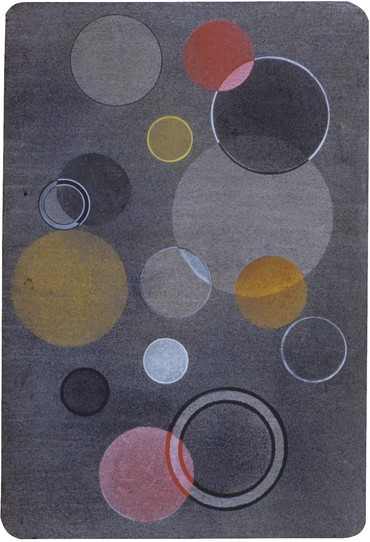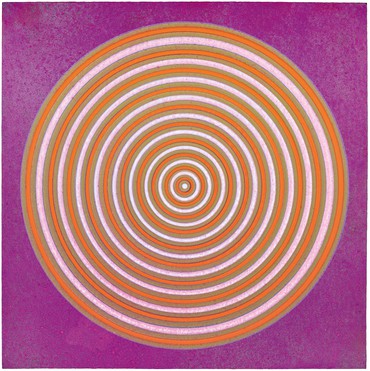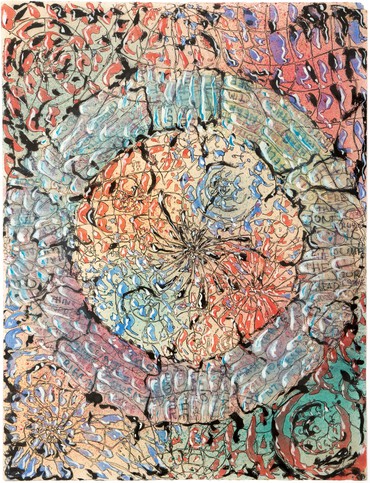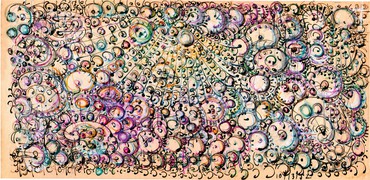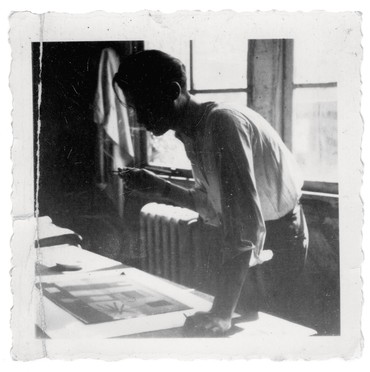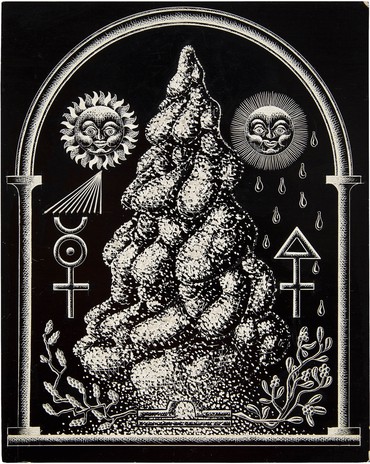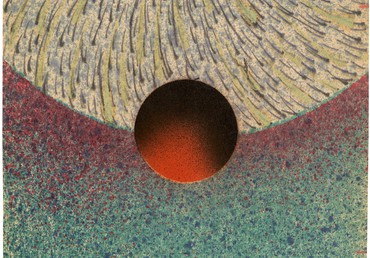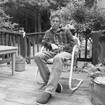
Raymond Foye is a contributing editor to the Brooklyn Rail. His most recent publication is Harry Smith: The Naropa Lectures 1989–1991 (2023). Photo: Amy Grantham
Art history can be a capricious affair: a complex chronicle constantly written and rewritten, based on changes in style, fashion, and collective consciousness. One of the more pronounced shifts in the cultural zeitgeist of recent years has been an attraction to works grounded in occult or esoteric traditions. Not so long ago, such concerns were quite simply the death knell for an artist. As recently as 2019, the Guggenheim Museum, New York, unexpectedly saw its exhibition of Hilma af Klint—a recondite spiritualist—attract 600,000 visitors, becoming the best-attended show in the museum’s history.
Two of the foremost pioneers of the occult aesthetic in America, Harry Smith and Jordan Belson, are currently enjoying long-overdue recognition. Since Smith’s death, in 1991, his reputation has exploded, with each year bringing new exhibitions, books, box sets of music, and restorations of films. The Getty Research Institute has devoted not one but two symposia to his work, and acquired his archives in 2013. This year, Farrar, Straus and Giroux will be publishing a full-length biography of Smith by John Szwed, who has written acclaimed biographies of Sun Ra, Miles Davis, Alan Lomax, and Billie Holiday. Smith’s Anthology of American Folk Music (Folkways Records, 1952) was rereleased on CD to great acclaim by the Smithsonian in 1997, and in 2020 Atlanta’s Dust to Digital label issued a companion box set of the B sides of the 78-rpm records on the Anthology—as if that artifact could not be more fully excavated. Currently in preparation are recordings of over one hundred songs and chants of the legendary kabbalist Rabbi Naftali Zvi Margolies Abulafia, made by Smith on the Lower East Side in 1953–54, as well as his 1982 Naropa Institute lectures on Native American cosmology, “The Rationality of Namelessness.” Smith has become a one-man culture industry, astonishing for someone who spent his final years shuffling between homeless shelters on the Bowery before dying penniless in a small room in the Chelsea Hotel.
Because Belson was extremely reclusive in the later part of his life, his career has lagged behind Smith’s by about two decades, but that has also begun to change. In Dark Star: Abstraction and Cosmos, an exhibition at the Planthouse gallery, New York, in 2016, Belson’s work was shown alongside that of Smith, Tamara Gonzales, Philip Taaffe, and others. Cosmic Communities: Coming Out Into Outer Space—Homofuturism, Applied Psychedelia & Magic Connectivity, at the Galerie Buchholz, New York, in 2017–18, set Belson alongside Tony Conrad, Jutta Koether, Sigmar Polke, Sun Ra, and more. These shows were followed in 2019 by a major solo exhibition of paintings at the Matthew Marks Gallery, New York, and by important European museum exhibitions in Barcelona, Geneva, and London. Brooklyn-based Zap Cassettes is bringing out a release of Belson’s home-recorded autoharp music this year, and experimental musician Henry Kaiser is collaborating with the Belson estate on a series of releases of Belson’s tape compositions from the 1970s and ’80s.
What many people are not aware of is the close relationship between these two artists at the outset of their careers. For eight years, from 1946 to ’53, they were friendly rivals—the Pablo Picasso and Georges Braque of nonobjective art on the West Coast, promoting each other’s work and sharing enthusiasms, discoveries, and occasionally studio space and art supplies. They also shared a mutual patron in the legendary Hilla Rebay, cofounder of the Guggenheim Museum. Indeed, Smith’s letters from that time to Rebay, preserved in the museum’s archives, reveal a side that those who knew him later in his life might find hard to imagine: a highly organized self-promoter.
Although Belson and Smith would eventually stray from the aesthetic orthodoxy imposed by Rebay and her personal mentor, the painter Rudolf Bauer, their fealty to the philosophy of nonobjectivism would never waver. In fact their elaborations on that aesthetic—testing and stressing the ideas of Bauer and Vasily Kandinsky, applying them to the mediums of light and sound while engaging with such disparate concerns as yoga, psychedelics, the kabbalah, and nasa space exploration—would lend continuing relevance to its principles and would have an enduring legacy in the popular imagination that continues to engage viewers today.
Belson was born in Chicago in 1926, but his family moved to New York when he was an infant; a decade later they departed for San Francisco, where his mother’s relations had settled. Raised in that city, Belson attended Lincoln High and took weekend life-drawing classes at the San Francisco Art Institute. Like Smith, he excelled at all things precise and mechanical, and while still a high school student he was highly valued at his father’s home-improvement business for his skill at measuring, cutting, and laying intricate linoleum designs. Belson earned his AB in studio art from the University of California, Berkeley, and he established a studio in Berkeley shortly after graduation.
Born in Portland, Oregon, in 1923, Smith too gravitated to Berkeley. His arrival there, like most aspects of his life, is shrouded in myth, but he himself told me that he first visited the town on a weekend trip to see Woody Guthrie perform at a union rally for the Industrial Workers of the World, taking a few days off from his job at the Boeing factory in Washington state. (Because of a curvature of the spine that stunted his growth, he was ineligible for the draft during World War II, but contributed to the war effort by doing electrical wiring in airplanes. His small size allowed him to crawl into tight spaces and his mechanical-mindedness was perfect for following electrical schemata.) It was at this same rally that he smoked marijuana for the first time, accepting a joint from Guthrie himself—or so he told me; he is also on the record saying that his benefactor was the legendary Berkeley bohemian Griff Borgeson. Once the war ended, Smith returned to Berkeley and found a small studio in a garage off Telegraph Avenue.
Although San Francisco would become the symbol of so much of the counterculture of the ’50s and ’60s, it was in Berkeley in the late ’40s that the seeds of that revolution were planted. The town was still quite small and rural in character; there were lodges for theosophy and the Vedanta, and many Native American traditions were still extant. Smith felt at home among the redwoods, which reminded him of his native Pacific Northwest.
The presence of an advanced university meant uncommon access to medievalists, anthropologists, and folklorists. For the poet Robert Duncan during these same years, studies with the medievalist Ernst Kantorowicz proved a defining encounter, as evidenced in two of Duncan’s earliest books, Heavenly City Earthly City (1947) and Medieval Studies (1950). While not formally a student at the university, Smith was in contact with anthropologists Jaime de Angulo and Paul Radin and with English professor and ethnomusicologist Bertrand H. Bronson, providing him with very different inspirations from anything he would have encountered almost anywhere else.
While still a high school student, Smith had begun recording the music and dances of the local Lummi and Salish tribes of the Pacific Northwest, and by the time he moved to Berkeley his collection of 78’s numbered in the hundreds and included blues, jazz, folk, and world music. These ethnographic interests persisted throughout his career, not only in terms of fieldwork but as generative patterns that informed and inspired all his visual art. For Smith, folkways—music, dance, weaving, basketry, quilting, etc.—were the antidote to the modern tendency toward mechanization. Even in those early days, Belson would recall, Smith had a pronounced antagonism toward the Western canon: he approved of no Europe-centric art, including that of the Renaissance, and he avoided traditional materials such as oils and canvas. In signing his works “delt,” short for the Latin delineavit, he even signaled his rejection of the designation “artist” in favor of the medieval-Latin term “delineator,” one who draws lines between one thing and another. “He always had a rather scornful attitude towards artists,” Belson once said. “He didn’t like to be thought of as one. He thought of himself as some sort of anthropologist or something of that sort. I can understand why he didn’t want to be identified with artists: from his point of view they were just pathetic misfits. Intellectually they didn’t interest him at all.”1
Belson delightfully recalled his first encounter with Smith in an interview with Paola Igliori:
I met Harry in Berkeley about 1946 and I think I was still a student there at the university, my last year. I had a coterie of friends that were all artists and a generally bohemian group, and one of them went for a walk in the hills. . . . It’s a university town, a lot of trees; it’s built on a hillside and it’s got a lot of beautiful red-wood homes, and he went for a walk up there around the fraternity houses and he looked. There was one window that was at eye level so he had no problem looking in—not intentionally—but the interior of the room was so striking that he peeked in the window and looked it over and then came back and mentioned this to me, and maybe another person or two, and we went up to take a look ourselves. It was like a little museum gallery in there. It was all very neat, lit romantically, with lights right over some artwork on the wall, and he had a Kachina doll, and a few mysterious paintings, and nothing much more than that. He had a very tidy bunk, a cot in one corner, and a rather large desk, and it was a nice little room. And as we were looking through the window he came out and invited us in . . . for tea—peppermint tea. He was so odd and strange—you know, gnomelike, intense creature, that I don’t think any of us knew quite what to make of him. . . . He just seems so strange and we were all fairly naïve—never met anybody quite like Harry. He was extremely ingratiating, charming and dressed in a sort of shabby professorial manner with a tie and a dress shirt and a regular jacket—none of us were like that. We were all very sloppy, paint-smeared art students. He had a few strange phonograph records around—he played for us jazz, very antique jazz recordings. He didn’t have very many records around—he had a huge collection somewhere but I never saw it. They were old and scratchy, a lot of hillbilly music, and his own paintings were sort of like . . . Paul Klee I guess would be the nearest thing. . . . He was a very mysterious but intriguing character.2
Over the next few years, Belson began making regular visits to Smith in the Berkeley studio. During this period, circa 1946–49—dates where Smith is concerned always involve guesswork—Smith had begun to make his first films, later collected as “Early Abstractions.” These were made by highly intricate hand-painting with colored inks directly on 35mm film stock. A three-minute film could take more than a year to make. These are foundational works of the psychedelic aesthetic.
Although Smith, being three years older than Belson, was in some ways more advanced in his artistic development, Belson had an impressive career at an early age—to say the least. His art-world debut came when he was nineteen, in the First Pasadena National exhibition at the Pasadena Art Institute (later renamed the Norton Simon Museum) in the spring of 1946. This was a large and important show that included artists from all forty-eight states, and Belson represented California along with Charles Houghton Howard, an exponent of biomorphic abstraction and Surrealism, who had a retrospective at the California Palace of the Legion of Honor that same year. Later that fall, at the age of twenty, Belson was included in the Sixty-Sixth Annual Exhibition of the San Francisco Art Association at the San Francisco Museum of Art, curated by Douglas MacAgy and David Park, which also included the painters Richard Diebenkorn and Elmer Bischoff.
In 1946, Smith and Belson began attending the inaugural screenings of the Art in Cinema series at the San Francisco Museum of Art (the word “Modern” had not yet been added to the name). Originating as a touring program of experimental films circulated by the Museum of Modern Art in New York, the Art in Cinema series expanded under the direction of Frank Stauffacher and Richard Foster to include work by Maya Deren, James and John Whitney, Oskar Fischinger, Mary Ellen Bute, Hans Richter, and Viking Eggeling. Smith and Belson attended Art in Cinema programs religiously for the next four years, and Smith became Stauffacher’s unpaid assistant.3 Smith was especially attracted to the films of Fischinger and in the summer of 1947 traveled to Los Angeles to meet him. He would end up meeting John Cage, Merce Cunningham, and many figures of the Los Angeles avant-garde at Fischinger’s house. A network between the experimental filmmakers of San Francisco and Los Angeles was established. And it was Fischinger who made the important introduction to Smith and Belson’s future patron, the Baroness Hilla Rebay von Ehrenwiesen.
Rebay believed passionately in the cause of nonobjective painting. The three corresponded, and Rebay sent her translations of Kandinsky’s Concerning the Spiritual in Art (1911) and Point and Line to Plane (1926), both recently published by the Guggenheim Foundation and both formative texts for Smith and Belson. Rebay was particularly devoted to the work of Bauer, whom she’d rescued to the United States, literally buying his way out of a Gestapo prison. When Rebay visited the Bay Area in 1948, Belson and Smith picked her up in Belson’s Ford Model T and they drove to Belson’s studio in North Beach and then to Smith’s studio on Buchanan Street in the Fillmore district, where he kept a shabby room above a small jazz club called Jackson’s Nook. (Jimbo’s Bop City, the legendary bebop club where he later lived and painted murals, was two blocks away.) The visit resulted in stipends and small acts of generosity over the next few years—with the explicit understanding that the two men were to promote the agenda of nonobjective art. And although in time both Smith and Belson defected from Rebay’s camp, their fealty to nonobjectivism would never waver; it merely took other forms, including animated film and various protopsychedelic multimedia works leading directly to the light shows of the ’60s.
Belson’s letters to Rebay from this period reflect his personality: cordial, reserved, diffident. Smith’s, on the other hand, are downright effusive, and constitute an important chronicle of this crucial period in his development as he became increasingly engaged with film and its potential for interaction with jazz musicians, whom he considered the truly advanced artists of the time. His letters contained abundant discussions of artistic matters, interspersed with pleas for money:
I will make prints of any of the color [films] you want a little later, but right now I can not do so, as I must live totally on the 65 dollars a month I get from you, as time is short and I can’t waste it bothering with trying to get money. I eat only two meals a day now, but drink lots of water and eat nothing with white flour or sugar in it, so I save money and I hope improve my health at the same time. . . . Since I showed my films at the museum here using live musicians improvising from the images rather than from a score, the musicians who gather nightly in the back room of a cafe near here, to play for their own amusement, after they have their regular jobs, have asked me to bring my projector to their “Jam Session” several times, because now everyone wants to try playing while looking at the film. . . . Last month I luckily borrowed a tape recorder and made records of about thirty different performances of musicians following the films. By comparing these tapes with each other and with the films it has been possible to make a start toward an investigation of intuitive creation.4
This last sentence shows Smith the great systematizer, continually trying to apply an analytic framework to matters of the imagination, a hopeless task to which he would brilliantly devote the rest of his life.
The years from 1947 until the end of 1951 were a period of prodigious experiment for both artists. Light proved an irresistible medium, and the addition of jazz soundtracks made for an entirely new filmic experience. Belson responded to Smith’s hand-painted films with a technique of his own: having exquisitely hand-painted paper scrolls in watercolor and gouache, he would then photograph each painted frame to create animated sequences. (After his death these scrolls were discovered carefully rolled in a closet, where they’d been stored for almost sixty years.) A home movie from 1951 called Autobiography, shot by Belson and Smith in Belson’s North Beach apartment, depicts the classic Beat pad with Smith and Belson’s paintings on the wall, a 16mm projector, and appearances by filmmakers Hy Hirsh and Chris Maclaine and poets Philip Lamantia, Weldon Kees, and Gerd Stern.
Both Belson and Smith had become bebop fanatics by now. “It was simply the most radical thing at the time,” Belson told me. They used jazz recordings as film soundtracks, and circa 1948–50 Smith also created a series of three-dimensional abstract paintings, inspired by Rebay’s works from the same period, which in turn were based on Kandinsky’s seminal Improvisations (1909–13). In Smith’s “jazz” paintings each stroke corresponds to a solo (or entire record) by Dizzy Gillespie, Thelonious Monk, or Charlie Parker. These paintings are now lost, and exist only on color slides that Belson had the foresight to purchase from Smith and preserve. (In his home studio fifty years later, Belson played me Gillespie’s “Manteca” while tracing with his finger the visual equivalents in Smith’s painting—and the correspondence was exact.) Belson and Smith created several closely related groups of work in 1951–53. Together they devised the idea of “Brain Drawings,” depictions of pure consciousness as glyphic mind-maps; they explored the kaballah in many works (Belson was Jewish, Smith was not), a subject that would deeply preoccupy Smith; and they developed their respective calligraphic styles, influenced by Chinese painting (Belson’s Peacock Book, forty-four drawings from 1952–53) and Tibetan mandalas (Smith’s Untitled Drawing, October 19, 1951). In a letter to Smith scholar Rani Singh in 2002, Belson described the latter as “a painting Smith made in my studio one afternoon in 1951, using paint and inks I had mixed for my own scroll films. The words partially concealed were probably extracted from our conversation.”
By late November of 1951, Smith was in New York, as we know from a letter from Rebay that included a cash enclosure for a Thanksgiving dinner.5 He had moved here sometime in the late fall of 1951 to fulfill two burning desires: to meet Marcel Duchamp and to hear Monk live. Monk could not leave New York because of a drug arrest and subsequent revocation of his cabaret card. Smith sought him out in the city’s clubs and became a regular at his shows for the next ten years. About Duchamp, sadly, we do not know.
Smith also had an introduction to Lionel Ziprin, artist, poet, and kabbalist. (Rabbi Abulafia, whose liturgical chants Smith would later record, was Ziprin’s grandfather.) Ziprin and his wife, Joanne, had just established a greeting-card and design firm, Inkweed Studios, in their kitchen, at 128 Lexington Avenue, and Smith was enlisted. Within the year, Belson had moved to New York to work at Inkweed. Incredibly, they were joined shortly thereafter by Bruce Conner, and the three artists spent many evenings in the Ziprin kitchen designing greeting cards. By this point Smith’s and Belson’s style had become so closely entwined, it is often a challenge to make accurate attributions between the two in the Inkweed archives (now managed by Ziprin’s daughter Zia Ziprin and artist Carol Bove). It was at Inkweed that Smith created perhaps his most famous artwork, The Tree of Life in the Four Worlds (1953), printed in an edition of 500 copies from collotype plates—executed by Jordan Belson.
For a time, both Belson and Smith shuttled between coasts, but after 1953 Smith was settled in New York and Belson returned to San Francisco. Although the personal friendship ended, they continued to follow each other’s work. In the late ’50s Belson and Henry Jacobs launched the influential Vortex concerts, multimedia shows with films, lasers, visual projections, and experimental music, which ran for two years at the Morrison Planetarium in Golden Gate Park, attracting the “heads” of San Francisco and leading directly to the light shows of the 1960s. Smith pursued his own highly elaborate multimedia presentations at the Film-Makers’ Cooperative in New York, albeit on a more personal scale. In 1964, Belson received a Ford Foundation Fellowship and the next day got a call from Smith requesting half of the money. They had not spoken in ten years. “On what basis am I supposed to give you half the money?” Belson asked. “On the basis that I turned you on to marijuana,” Smith replied. How did you feel about that, I once asked Belson. “I was glad he was on another coast,” he answered. In 1970 Belson traveled back east to work with the Egyptologist André VandenBroeck on a film soundtrack, and although he flew into and out of New York, he drove directly upstate to VandenBroeck’s house and did not visit Manhattan.
In the ensuing decades Smith continued to paint, make films, and issue recordings before accepting a position as shaman-in-residence at Naropa Institute in Boulder. In 1991, a few months after receiving a Grammy Lifetime Achievement award, he died in the Chelsea Hotel, where his rent was being paid by the Grateful Dead’s Rex Foundation. He was sixty-eight years old. Belson outlived him by twenty years, no doubt the result of a more sedate lifestyle of vegetarianism and yoga. He completed his thirty-fifth and final film in 2005 and devoted his final years to a stunning body of pastels depicting his enduring subject: the intersection of inner and outer space. “I think Belson is unique in that he’s an artist who moves back and forth between filmmaking and painting, in discrete groups of four or five years spaced apart, and he creates masterpieces in both those realms,” Gerd Stern told The Brooklyn Rail in 2019. “I don’t know any other artist in the 20th century who does that. He was unique because the characteristics of his personality and his reclusiveness are part of what made him into a brilliant artist/technologist, so that’s an unusual combination.”
It is ironic that in many instances we know more about what took place in ancient Egypt than about what took place seventy-five years ago on Telegraph Avenue in Berkeley or Grant Avenue in San Francisco. The radical changes that Harry Smith and Jordan Belson instigated together are still being excavated—works that in many ways remain as radical as the day they were created.
1Jordan Belson, in telephone interviews with Scott MacDonald made between 1992 and 1994. I am quoting from the unpublished original transcripts made available to me by the author, who later edited and published them in MacDonald, A Critical Cinema 3: Interviews with Independent Filmmakers (Berkeley: University of California Press, 1998).
2Belson, quoted in Paola Igliori, American Magus: Harry Smith, A Modern Alchemist (New York: Inanout Press, 1996), p. 19.
3I am indebted here to Harry Smith biographer John Szwed for access to his unpublished research.
4Smith, letter to Hilla Rebay, June 17, 1950. Guggenheim Museum Archives.
5Rebay, letter to Smith, November 17, 1951. Guggenheim Museum Archives.

